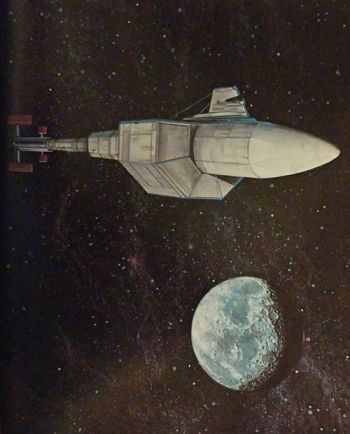Difference between revisions of "DY-500 class"
From Trekipedia
m |
|||
| Line 1: | Line 1: | ||
==FASA Timeline== | ==FASA Timeline== | ||
[[File:dy500_class-sfc.jpg|350px|thumb|right|[[DY-500 class#FASA Timeline|DY-500 class]] ([[Star Trek: Spaceflight Chronology (Book)|SFC]])]] | [[File:dy500_class-sfc.jpg|350px|thumb|right|[[DY-500 class#FASA Timeline|DY-500 class]] ([[Star Trek: Spaceflight Chronology (Book)|SFC]])]] | ||
| − | In [[FASA Chronology: 2010s#2019|2019]], the [[DY-100 class#FASA_Timeline|DY-100 class]] underwent extensive design and performance upgrades to become the [[DY-500 class#FASA_Timeline|DY-500 class]].<ref name="SFC"/> | + | In [[FASA Chronology: 2010s#2019|2019]], the [[DY-100 class#FASA_Timeline|DY-100 class]] underwent extensive design and performance upgrades to become the [[DY-500 class#FASA_Timeline|DY-500 class]]. The Amjet V Thrusters were the most efficient engines of the 21st century, and the magnetohydrodynamic generator provided all on-board power. The class was particularly popular for travel to and within the asteroid belt, and it remained in service until [[FASA Chronology: 2050s#2055|2055]].<ref name="SFC"/> |
===DY-500 class vessels=== | ===DY-500 class vessels=== | ||
| Line 8: | Line 8: | ||
* [[U.N.S.S. Wheeler (DY-500)|U.N.S.S. ''Wheeler'']] | * [[U.N.S.S. Wheeler (DY-500)|U.N.S.S. ''Wheeler'']] | ||
| + | <div style="width:20%;float:left;margin-right:.25em;"> | ||
| + | ===Specifications=== | ||
| + | {| | ||
| + | |- | ||
| + | |class="HeaderRow ButtonLeft" style="width:25%;text-align:left;vertical-align:top;"|Length | ||
| + | |style="vertical-align:top;"|145[[meter|m]] | ||
| + | |- | ||
| + | |class="HeaderRow ButtonLeft" style="width:25%;text-align:left;vertical-align:top;"|Beam | ||
| + | |style="vertical-align:top;"|33[[meter|m]] | ||
| + | |- | ||
| + | |class="HeaderRow ButtonLeft" style="width:25%;text-align:left;vertical-align:top;"|Draught | ||
| + | |style="vertical-align:top;"|47[[meter|m]] | ||
| + | |- | ||
| + | |class="HeaderRow ButtonLeft" style="width:25%;text-align:left;vertical-align:top;"|Mass | ||
| + | |style="vertical-align:top;"|4.17 million [[kilogram|kg]] | ||
| + | |- | ||
| + | |class="HeaderRow ButtonLeft" style="width:25%;text-align:left;vertical-align:top;"|Cargo Modules | ||
| + | |style="vertical-align:top;"|Each 19.8x10.7[[meter|m]] (2900[[cubic meter|m³]] usable volume) | ||
| + | |- | ||
| + | |class="HeaderRow ButtonLeft" style="width:25%;text-align:left;vertical-align:top;"|Ship's Complement | ||
| + | |style="vertical-align:top;"| | ||
| + | * Officers: 3 | ||
| + | * Crew/ Passengers: 33 | ||
| + | |} | ||
| + | </div> | ||
| + | <div style="width:20%;float:left;margin-right:.25em;"> | ||
| + | ===Performance=== | ||
| + | {| | ||
| + | |- | ||
| + | |class="HeaderRow ButtonLeft" style="width:25%;text-align:left;vertical-align:top;"|Range (Standard) | ||
| + | |style="vertical-align:top;"|600 million [[kilometer|km]] | ||
| + | |- | ||
| + | |class="HeaderRow ButtonLeft" style="width:25%;text-align:left;vertical-align:top;"|Range (Maximum) | ||
| + | |style="vertical-align:top;"|1.15 billion [[kilometer|km]] | ||
| + | |- | ||
| + | |class="HeaderRow ButtonLeft" style="width:25%;text-align:left;vertical-align:top;"|Velocity (Cruising) | ||
| + | |style="vertical-align:top;"|135,000 [[kilometer|km]]/hour | ||
| + | |- | ||
| + | |class="HeaderRow ButtonLeft" style="width:25%;text-align:left;vertical-align:top;"|Typical Voyage Duration | ||
| + | |style="vertical-align:top;"|185 days ([[Earth]]-[[Asteropolis]]) | ||
| + | |- | ||
| + | |class="HeaderRow ButtonLeft" style="width:25%;text-align:left;vertical-align:top;"|Thrust | ||
| + | |style="vertical-align:top;"|33,000 [[kilogram|kg]] per fission engine | ||
| + | |} | ||
| + | </div> | ||
| + | <div style="width:20%;float:left;margin-right:.25em;"> | ||
| + | ===Systems Overview=== | ||
| + | {| | ||
| + | |- | ||
| + | |class="HeaderRow ButtonLeft" style="width:25%;text-align:left;vertical-align:top;"|Navigation | ||
| + | |style="vertical-align:top;"|Interplanetary Triangulation (3 body) Guidance | ||
| + | |- | ||
| + | |class="HeaderRow ButtonLeft" style="width:25%;text-align:left;vertical-align:top;"|Communication | ||
| + | |style="vertical-align:top;"|Laser Radiotelemetry | ||
| + | |- | ||
| + | |class="HeaderRow ButtonLeft" style="width:25%;text-align:left;vertical-align:top;"|Onboard Power | ||
| + | |style="vertical-align:top;"|Magnetohyydrodynamic Electric Generator | ||
| + | |- | ||
| + | |class="HeaderRow ButtonLeft" style="width:25%;text-align:left;vertical-align:top;"|Computer | ||
| + | |style="vertical-align:top;"|Elementary Independent Thought Processing Digital | ||
| + | |- | ||
| + | |class="HeaderRow ButtonLeft" style="width:25%;text-align:left;vertical-align:top;"|Gravity | ||
| + | |style="vertical-align:top;"|.2[[gravity|g]] internally sustained | ||
| + | |- | ||
| + | |class="HeaderRow ButtonLeft" style="width:25%;text-align:left;vertical-align:top;"|Atmosphere | ||
| + | |style="vertical-align:top;"|25% [[oxygen|O<sub>2</sub>; 9% humidity | ||
| + | |- | ||
| + | |class="HeaderRow ButtonLeft" style="width:25%;text-align:left;vertical-align:top;"|Sustenance Duration | ||
| + | |style="vertical-align:top;"|424 days at standard ship's complement of 36 | ||
| + | |} | ||
| + | </div> | ||
| + | |||
| + | <div style="clear:both;"></div> | ||
==References== | ==References== | ||
<references> | <references> | ||
Revision as of 10:13, 27 April 2019
FASA Timeline
In 2019, the DY-100 class underwent extensive design and performance upgrades to become the DY-500 class. The Amjet V Thrusters were the most efficient engines of the 21st century, and the magnetohydrodynamic generator provided all on-board power. The class was particularly popular for travel to and within the asteroid belt, and it remained in service until 2055.[1]
DY-500 class vessels
Specifications
| Length | 145m |
| Beam | 33m |
| Draught | 47m |
| Mass | 4.17 million kg |
| Cargo Modules | Each 19.8x10.7m (2900m³ usable volume) |
| Ship's Complement |
|
Performance
| Range (Standard) | 600 million km |
| Range (Maximum) | 1.15 billion km |
| Velocity (Cruising) | 135,000 km/hour |
| Typical Voyage Duration | 185 days (Earth-Asteropolis) |
| Thrust | 33,000 kg per fission engine |
Systems Overview
| Navigation | Interplanetary Triangulation (3 body) Guidance |
| Communication | Laser Radiotelemetry |
| Onboard Power | Magnetohyydrodynamic Electric Generator |
| Computer | Elementary Independent Thought Processing Digital |
| Gravity | .2g internally sustained |
| Atmosphere | 25% [[oxygen|O2; 9% humidity |
| Sustenance Duration | 424 days at standard ship's complement of 36 |
References
- ↑ Goldstein, Stan and Goldstein, Fred with Sternbach, Rick. Star Trek: Spaceflight Chronology. Pocket Books, 1980.
